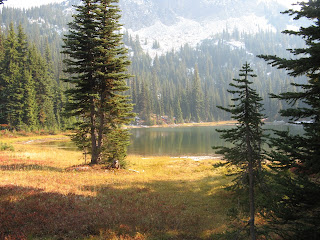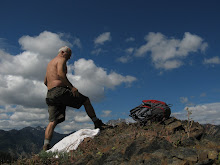


I try to get out just one time each summer on a little overnight trip, not only because I enjoy it tremendously and to keep in touch with my backpacking side, but to remind me of how difficult and challenging it can be. This trip was no exception: by the time I got to my destination I was already wishing I was back at the car, on my way home to enjoy a nice cold beer. My shoulders were aching, my thighs were burning and blisters were already forming on both heels.
The hike started out great, at about 930 in the morning, from the Cathedral Pass trailhead, at the very end of the Salmon la Sac road, just north of swampy Tucquala Lake. As a rare treat, Tuuli was with me for the first few miles, the first time we had been hiking together in years. The trail starts steeply up the dark side of Goat Ridge, switchbacking through a thick tangle of mossy firs and pines. At about 4500', most of the underbrush is gone, views open up and once the top of the ridge is reached, the sun came on like a furnace. The trail now continues north to Cathedral Rock and the nearby Squaw Lake, or you can hang a left and head south on the aptly named Trail Creek Trail, which ultimately leads to Waptus Lake and more specifically to the Goat Peak area, where I was headed. Here Tuuli and I parted company as it was getting late and I had to get trucking to reach my destination in time for dinner. She went to the lake and headed back home.
I had another 5 or 6 miles to go, the first couple of miles being very flat and scenic with the trail just sort of meandering through an open forest, occasionally crossing dried-up stream beds and for a very short while paralleling the quite pretty Trail Creek. Much of the area was strangely flat and open, but with few view opportunities--unusual for the high country. Of course it was very quiet with no signs of other hikers. The trail then began to lose elevation and finally at the bottom of a little gully was my turnoff, signed "Lake Michael."
The lost elevation was immediately regained, as the rough and rocky trail immediately began to climb the west flank of Goat Ridge. Nondescript at this point, the trail wound through open pine forests and blueberry bushes that had turned bright red. As the elevation approached 5000' the trail flattened out, which was a pleasant change for my worn out thighs and shoulders. The pack now felt like it weighed a hundred pounds and no matter how I adjusted the straps, I just couldn't get comfortable.
I began studying the GPS closely looking to find the best place to turn off the trail to get to my lake. The distance to the lake got down to about 1.3 miles and then started increasing, so I figured I wasn't going to get much closer. I found a little deer path and worked my way toward east and in about 1/2 hour crested a hill and looked down and saw water. It was about 5pm, the lake was bathed in a golden, late afternoon light and the acres of surrounding blueberry bushes appeared to be on fire. The unnamed lake was nestled into a little bowl with Goat Ridge to the east, Goat Peak to the south and a lovely beckoning meadow, just begging for a tent to be pitched.
After about an hour, the tent was pitched, just a few feet from the lake's edge and by 630 I was enjoying a lovely little freeze-dried Phad Thai, or Bhad Thai, as it will henceforth forever be known. A typical restless night ensued, with occasional glimpses of a black sky filled with thousands of light-filled holes. By midnight, the full moon had risen over the ridge, putting out the stars. I spent the rest of the night listening to the little FM radio on my cell phone and officially "got up" at 630am. I immediately brewed some of the Starbuck's Via instant coffee and spent the next couple hours sitting in front of the tent, waiting for critters to show up. In the end all I saw were a few birds and a couple chipmunks. Curiously, there was an area of flattened grass nearby that I had remembered from the night before. I have to assume some deer had slept there, but had done so so quietly that I never noticed.
At around 9, I started up to the top of the ridge to get a closer look at Goat Peak, which I had hoped to climb. I found that my planned route was impassable due to a recent snowfall, so I spent a few minutes with the binoculars looking for goats, without any luck. I walked south on the wide open ridge for about a mile and then worked my way back to the lake. I packed up my things and by noon I was on the way back home.
Things I learned from this hike:
a) Fleece pants a fleece sleeping bag liner don't mix--they stick to each other like velcro, making it difficult to move around
b) Invest in a better pack. The one I used for this hike was a bargain basement special. Much better to spend a few extra bucks, get a pack that's lighter, has more pockets and fits better.
c) Same can be said for the tent. While nice and light and very spacious I had one zipper nearly break and I tore the nylon in one of the corner where the pole is seated.
d) Don't experiment with non-traditional dishes like phad thai. Better to stick to the freeze dried classic like beef stew and lasagna.
e) You can never have too many batteries for your camera and your GPS.
f) Bring sleeping pills next time.








